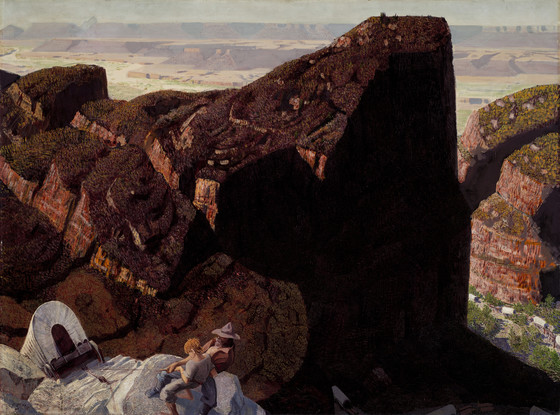In April 1879 an exploration party of Mormons left the Cedar City-Fillmore area of Utah to scout out southeastern Utah before a group went to colonize the area....
In April 1879 an exploration party of Mormons left the Cedar City-Fillmore area of Utah to scout out southeastern Utah before a group went to colonize the area. The larger party crossed Hole-in-the-Rock on their way to Bluff, where they eventually settled. Their passage was fraught with difficulties, not the least of which was the lowering of their wagons down the east slope of Hole-in-the-Rock, a process depicted in Westward.
Buff had first become interested in the history of the Mormons in the late 1920s when he was asked to decorate the Church of Jesus Christ of Latter Day Saints in Los Angeles. There he painted a series of lunettes depicting the original group of pioneering Mormons who moved West in 1847. For this and other commissions for smaller Mormon churches that he later received, Buff explored Nevada and Utah, travels which increased his admiration for members of the church.
The subject of Westward fascinated Buff and he made several versions of it in oil as well as a lithograph. A photograph of Westward I in the transcript of the Buff interview in the Oral History Program, University of California, Los Angeles, and given the date 1933 is of a version similar to the museum’s painting in overall conception, but it differs in details of the rock formation and the wagon train and in the placement of the signature. The next year he completed a large oil on canvas mural, Westward II (Santa Monica [Calif.] High School), for the Public Works of Art Project. In it the details of geography differ somewhat from those in the museum’s painting and Buff added in the foreground a cliff on which a pioneer mother and two children perch precariously. In 1934, the same year he painted the mural Westward II he included in his solo exhibition at the Stendahl Art Galleries a painting titled Hurricane Pass on the Covered Wagon Trail in Southern Utah. Judging by its reproduction in the Los Angeles Times (July 22, 1934, pt. 2, p. 8) this appears to have been almost identical to the version now owned by the museum. Pentimenti in the museum’s painting indicate that the placement of the small figures in the foreground was changed slightly. This suggests that the museum’s version, which is undated, may have been first exhibited in 1934 as Hurricane Pass . . . and then changed slightly and given a new title. If so, the reason for the artist’s alterations are not known.
Buff’s typical subject was the Western mountain landscape, its dramatic forms rendered as bold, clear shapes with an almost architectural quality. Its historical subject and rustic figures (one posed for by the artist’s son) give Westward a more regionalist flavor. The genre element as well as the baroque viewpoint were typical of murals created in the 1930s.
Westward displays the technique of the artist’s earlier paintings: a thin underpainting of various colors applied in large areas of light and shade, each color enlivened by a series of short lines of a different and sometimes complementary color. The cliffs are maroon, orange, lavender, and beige; the distant hills are pastel blue, lavender, ocher, and green. The technique, which the artist described as "pointillist," may recall Italian divisionist painting, which he might have known from his youth in Switzerland and southern Germany. Buff maintained this mature style until he gradually broadened it in later life.
Although Buff was invited to exhibit paintings in his pointillist style with the city’s modernists in the early 1920s, Westward won the first prize in the "conservative class" at the museum’s Eighteenth Annual Exhibition: Painting and Sculpture, from which it was purchased. The Los Angeles art world had changed, but Buff had an individual style independent of the art movements around him.
More...
